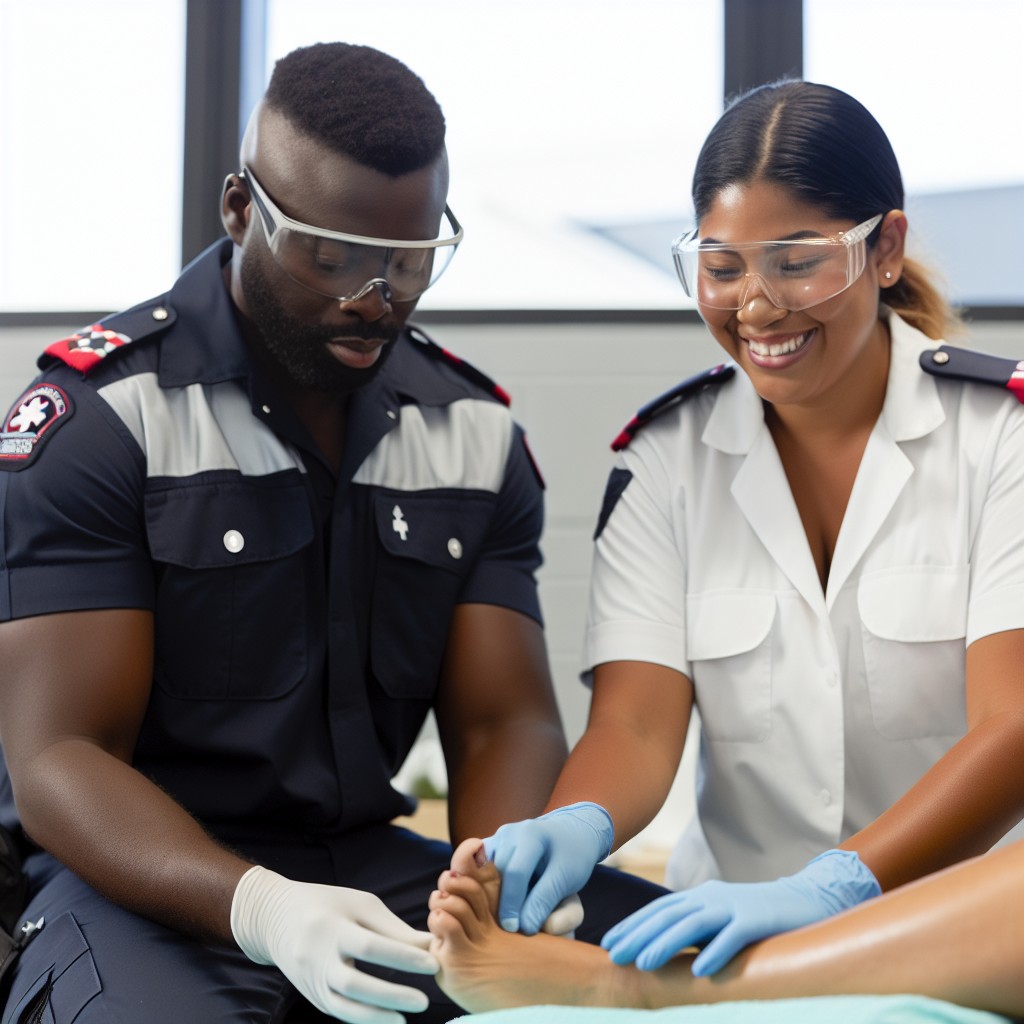Diverse Roles of Paramedics and Podiatrists in Australian Healthcare
Paramedics: Lifesavers in Emergency Care
Paramedics provide urgent medical care across urban and rural Australia.
They assess emergencies quickly to stabilise patients on-site.
Moreover, paramedics transport patients safely to hospitals for further treatment.
They collaborate closely with doctors and nurses during critical situations.
Paramedics also educate the public on first aid and emergency preparedness.
Podiatrists: Specialists in Foot and Lower Limb Health
Podiatrists diagnose and treat foot, ankle, and lower limb conditions.
They help patients manage chronic illnesses like diabetes that affect foot health.
Additionally, podiatrists perform biomechanical assessments to improve mobility.
They provide customised orthotics and rehabilitation therapies for various conditions.
Podiatrists work closely with general practitioners and physiotherapists to optimise patient outcomes.
Distinctive Contributions to Australia’s Healthcare System
Paramedics and podiatrists offer distinct but complementary healthcare services.
Both professions improve patient quality of life and community health resilience.
Together, they form an essential part of Australia’s diverse healthcare workforce.
Their specialised skills address immediate emergencies and long-term health needs effectively.
The Crucial Contributions of Paramedics Beyond Emergency Response
Expanded Roles in Community Health
Paramedics play an essential role well beyond emergency callouts.
Your Personalized Career Strategy
Unlock your potential with tailored career consulting. Get clear, actionable steps designed for your success. Start now!
Get StartedThey actively engage in ongoing community health initiatives.
For example, paramedics conduct home visits to manage chronic conditions.
Moreover, they provide health education that empowers patients daily.
These efforts reduce hospital admissions and improve overall wellbeing.
Integration with Primary Healthcare Services
Paramedics work closely with doctors and nurses in primary care settings.
They assist in monitoring patients with complex health needs regularly.
This collaboration ensures timely interventions and smoother care transitions.
Additionally, paramedics help to ease the pressure on emergency departments nationwide.
Responding to Mental Health Needs
Paramedics increasingly support mental health crisis response across Australia.
They receive specialised training to handle behavioural health emergencies calmly.
Consequently, they connect individuals to appropriate mental health services quickly.
Such support reduces repeated emergency visits and improves community safety.
Telehealth and Mobile Care Innovations
Paramedics utilise telehealth technology to consult with medical specialists remotely.
This innovation enhances diagnostic accuracy during patient assessments.
Stand Out with a Resume That Gets Results
Your career is worth more than a generic template. Let us craft a resume and cover letter that showcase your unique strengths and help you secure that dream job.
Get HiredFurthermore, mobile care units staffed by paramedics provide on-site treatments.
These services bring healthcare access to rural and underserved populations.
Education and Advocacy Efforts
Experienced paramedics like Rachel Mercer advocate for policy improvements nationwide.
They contribute to public health campaigns focused on injury prevention and safety.
Moreover, paramedics train new recruits, ensuring high standards continue.
These efforts strengthen the healthcare system’s resilience and responsiveness.
Podiatrists’ Impact on Managing Chronic Conditions and Improving Mobility
Role in Managing Chronic Conditions
Podiatrists play a vital role in managing chronic diseases such as diabetes and arthritis.
They focus on preventing complications through regular foot assessments and care.
For example, Dr. Emily Harrison from Bayside Podiatry Associates helps patients avoid ulcers and infections.
Moreover, podiatrists advise on lifestyle changes that reduce pressure and improve foot health.
They collaborate closely with general practitioners and endocrinologists for comprehensive care.
Additionally, podiatrists use advanced diagnostic tools to monitor circulation and nerve function.
These efforts significantly reduce the risk of amputations and hospital admissions.
Improving Mobility and Enhancing Quality of Life
Improving mobility is another crucial benefit podiatrists provide to patients.
Transform Your LinkedIn for Maximum Impact
Elevate your professional brand with a LinkedIn profile that attracts recruiters, showcases your expertise, and maximizes opportunities. Stand out in your industry with a profile built for success.
Boost ProfileThey develop personalized treatment plans to address pain and structural foot problems.
For instance, Karen Lawson at Riverside Foot Care has helped seniors regain their independence.
Therapies include custom orthotics, exercise guidance, and wound care management.
Furthermore, podiatrists educate patients on proper footwear to support active lifestyles.
They also work with physiotherapists and occupational therapists for holistic rehabilitation.
Consequently, many patients experience improved balance and reduced fall risks.
Community Outreach and Preventive Education
Besides clinical care, podiatrists actively engage in community health education.
They hold workshops to raise awareness about foot health in aging and vulnerable populations.
Dr. Thomas Nguyen frequently speaks at the Sydney Health Forum on early signs of foot problems.
Preventive education empowers individuals to seek timely care and avoid serious complications.
This proactive approach aligns well with Australia’s broader healthcare goals.
Ultimately, podiatrists significantly contribute to increasing overall population mobility and wellbeing.
Uncover the Details: The Role of Mental Health Nurses in Australia’s Wellbeing Journey
Challenges Faced by Paramedics and Podiatrists in the Healthcare System
Pressure and Workload Challenges for Paramedics
Paramedics like Lucas Bennett often work long, unpredictable hours under high stress.
They face demanding physical conditions while responding to emergencies.
Additionally, they handle emotionally intense situations involving critical and traumatic injuries.
Understaffing in many ambulance services increases their workload significantly.
This pressure often results in fatigue and burnout among paramedics nationwide.
Navigating complex patient needs within short response times challenges their decision-making.
Consequently, paramedics must balance rapid assessment with delivering high-quality medical care.
Limited access to mental health support complicates their ability to cope with job stress.
Hence, resilience training and peer support programs are crucial but not universally available.
Systemic and Administrative Barriers for Paramedics
Paramedics frequently encounter bureaucratic hurdles that delay critical interventions.
They also struggle with fragmented communication between hospitals and emergency teams.
This disconnect hampers smooth patient handovers and continuity of care.
Strict protocols sometimes limit their ability to adapt treatments on the spot.
Funding constraints reduce the availability of advanced medical equipment in ambulances.
Many paramedics feel undervalued despite their frontline role in healthcare.
Ongoing training requirements add administrative workload that pulls them away from patient care.
Physical and Health Challenges for Podiatrists
Podiatrists such as Emily Crawford often spend long hours standing and performing detailed procedures.
This physical demand can lead to repetitive strain injuries and chronic pain.
They face challenges treating patients with complex conditions like diabetes-related foot ulcers.
Delayed patient presentations worsen treatment outcomes and complicate care plans.
Limited public awareness about podiatry reduces early referrals and preventive care opportunities.
Consequently, podiatrists must often provide extensive education alongside treatment.
Financial and Recognition Issues Affecting Podiatrists
Many podiatrists deal with inconsistent reimbursement models from private insurers and government schemes.
This financial uncertainty impacts clinic sustainability and service accessibility.
Podiatry receives less recognition compared to other allied health professions.
This status imbalance affects funding, professional development, and recruitment.
Regulatory challenges also complicate podiatrists’ scope of practice across different Australian states.
Therefore, continuous advocacy is necessary to improve working conditions and professional status.
Common Challenges and Opportunities for Paramedics and Podiatrists
Both paramedics and podiatrists face workforce shortages that strain service delivery.
They must adapt to technological advances and integrate digital health tools rapidly.
Collaboration across healthcare sectors can mitigate some challenges through shared knowledge and resources.
Better recognition and support contribute to retaining these professionals in Australian healthcare.
Investing in their wellbeing and training ensures improved patient outcomes and system resilience.
Explore Further: How Midwives Make a Difference in the Lives of Australian Families
Training and Qualifications Required for Paramedics and Podiatrists in Australia
Education Pathways for Paramedics
Paramedics must complete a recognised tertiary qualification in paramedicine.
Most Australian universities offer a Bachelor of Paramedicine program.
For example, Charles Sturt University provides a comprehensive paramedicine degree.
Students learn clinical skills, anatomy, and emergency care techniques.
Additionally, courses include field placements to gain practical experience.
Registration and Accreditation for Paramedics
Paramedics need registration with the Paramedicine Board of Australia.
This registration is managed by the Australian Health Practitioner Regulation Agency (AHPRA).
Applicants must meet competency standards and demonstrate relevant qualifications.
Continuing professional development (CPD) is mandatory for maintaining registration.
Paramedics often work under the supervision of Ambulance Victoria, NSW Ambulance, or similar services.
Education Pathways for Podiatrists
Podiatrists must complete an accredited podiatry degree.
The Bachelor of Podiatry Science, followed by a Masters in Podiatric Practice, is a common pathway.
Institutions like the University of Western Australia offer recognised podiatry programs.
Studies focus on foot and lower limb anatomy, biomechanics, and disease management.
Students also undergo clinical placements to apply theoretical learning in real settings.
Registration and Accreditation for Podiatrists
Podiatrists require registration with AHPRA via the Podiatry Board of Australia.
They must hold an accredited qualification or recognized equivalency.
Practitioners comply with professional codes of conduct and annual CPD requirements.
The Australasian Podiatry Council oversees accreditation of educational providers.
Podiatrists often work in private clinics, hospitals, or community health organisations.
Learn More: How Dietitians Play a Vital Role in Australian Healthcare
The Importance of Interdisciplinary Collaboration Among Unseen Healthcare Heroes
Bridging Diverse Expertise to Enhance Patient Care
Paramedics serve crucial but often unseen roles.
Podiatrists also provide essential healthcare services.
These professionals bring unique skills that complement each other in treating patients.
Collaboration allows healthcare workers to provide comprehensive care.
For example, paramedics stabilize patients during emergencies.
Meanwhile, podiatrists handle specialized foot health issues.
Such teamwork ensures patients receive timely and appropriate treatment at every stage.
Fostering Communication and Coordination
Effective communication is vital to seamless collaboration.
Teams benefit from regular meetings and shared platforms.
These tools help exchange critical patient information efficiently.
Coordinated efforts reduce medical errors and improve patient outcomes.
Healthcare providers like Dr. Elena Harper emphasize the benefits of this synergy in regional hospitals.
As a result, patients experience smoother transitions between emergency care and ongoing treatment.
Positive Impact on Healthcare Systems and Communities
Interdisciplinary collaboration optimizes resource use across settings.
It minimizes duplication and accelerates patient recovery processes.
Collaborative care models at Sydney Northern Medical Centre demonstrate improved efficiency.
Communities benefit from stronger support networks and preventive care initiatives.
Overall, teamwork strengthens Australia’s healthcare system resilience and accessibility.
Gain More Insights: Future-Proof Healthcare Careers in Australia: Roles That Will Thrive in 2030

Community Awareness and Recognition of Paramedics and Podiatrists’ Roles
Visibility of Paramedics in Emergency Care
Paramedics play a critical role in Australia’s emergency healthcare system.
They respond quickly to accidents, medical emergencies, and critical situations.
Most people recognize paramedics from their urgent presence on the scene.
However, their work extends beyond emergency response to patient care during transport.
Moreover, paramedics provide crucial support in disaster situations and remote areas.
Paramedic Sarah Mitchell from Melbourne Ambulance shares stories that highlight their dedication.
Consequently, communities increasingly value the skills and compassion paramedics exhibit daily.
Understanding the Role of Podiatrists in Healthcare
Podiatrists specialize in foot and lower limb health, often unseen in mainstream healthcare.
Many Australians are unaware of the breadth of podiatry services available.
For example, podiatrists manage diabetic foot care to prevent serious complications.
Additionally, they treat sports injuries, provide orthotic solutions, and conduct surgical procedures.
Dr. Emily Chant, a Sydney podiatrist, educates patients on maintaining foot health.
She stresses early intervention to improve mobility and quality of life.
Therefore, recognizing podiatrists’ roles helps reduce long-term health costs and improve outcomes.
Community Initiatives to Raise Awareness
Local health organizations host events to showcase the contributions of paramedics and podiatrists.
These initiatives include open days, health talks, and school visits.
Notably, Gold Coast Health services launched a campaign to introduce podiatry care options.
Furthermore, Queensland Ambulance Service partners with communities for emergency preparedness workshops.
These programs foster greater understanding and trust between healthcare providers and the public.
Community leaders like Councillor Maya Nguyen endorse increased visibility of all healthcare roles.
Ultimately, such efforts empower citizens to engage proactively with healthcare professionals.
Future Career Opportunities and Growth Prospects for Paramedics and Podiatrists in Australia
Expanding Roles for Paramedics
Paramedics in Australia continue to see an expansion in their professional roles.
They are increasingly involved in community health and chronic disease management.
Moreover, paramedics are transitioning into extended care roles within healthcare systems.
This shift offers them opportunities to work in aged care and mental health services.
Paramedic educators and clinical supervisors are in demand to train the next generation.
Private companies like VitalMed Solutions Australia offer innovative paramedic career paths.
Growth in Paramedic Employment
The Australian government invests significantly in emergency medical services.
Consequently, job prospects for paramedics are strong across urban and rural areas.
Furthermore, ambulance services and private healthcare providers report steady workforce growth.
Organizations such as Queensland Ambulance Service frequently recruit new paramedics.
Paramedic career progression includes roles in management and specialist paramedicine.
Emerging Opportunities for Podiatrists
Podiatry remains a vital and growing profession in Australia’s healthcare system.
Practitioners increasingly address complex diabetic foot care and sports injuries.
Consequently, podiatrists find new roles in multidisciplinary healthcare teams.
Private clinics like Southern Podiatry Group expand their services, creating new job openings.
Innovation in orthotic technology and telehealth provides podiatrists with varied career options.
Increasing Demand for Podiatric Services
The ageing Australian population drives greater demand for podiatric care.
This demographic shift results in more opportunities in chronic wound management and mobility support.
Healthcare networks like Victorian Integrated Podiatry actively seek skilled practitioners.
Additionally, research and academic positions for podiatrists are growing nationwide.
These roles help advance treatment techniques and patient outcomes.
Education and Professional Development
Both paramedics and podiatrists benefit from continuous education programs.
Universities such as the University of Melbourne offer advanced degrees and certifications.
Ongoing professional development ensures practitioners stay current with healthcare trends.
Furthermore, professional bodies like Paramedics Australasia and the Australian Podiatry Association support career growth.
They provide networking, training, and advocacy opportunities for their members.
Projected Growth Within the Australian Healthcare Sector
The healthcare sector anticipates strong growth in allied health professions.
This positive outlook appeals to new graduates considering paramedicine and podiatry careers.
Technological advancements will create new services, expanding job roles further.
Likewise, government policies emphasize community-based care where these professionals excel.
Therefore, paramedics and podiatrists will remain essential and valued healthcare contributors.
Case Studies of Paramedics Driving Lifesaving Outcomes
Rapid Response Saves Lives in Remote Communities
Paramedic Sarah Thompson responded swiftly to a cardiac arrest in rural Queensland.
She administered CPR and used a defibrillator within minutes of arrival.
Consequently, the patient regained consciousness before ambulance transport.
This rapid intervention significantly increased the patient’s chances of survival.
Later, the patient credited Sarah’s calm professionalism for saving his life.
Innovative Care Reduces Hospital Admissions
At Sydney’s Northern Emergency Service, paramedic Rajesh Patel implemented advanced triage protocols.
This approach enabled more patients to receive treatment on-site rather than in hospital.
As a result, hospital overcrowding decreased, benefiting both patients and healthcare staff.
Rajesh collaborates closely with local GPs to coordinate patient follow-ups effectively.
His work illustrates how paramedics contribute beyond emergency scenes.
Case Studies of Podiatrists Enhancing Quality of Life
Diabetic Foot Care Prevents Amputations
Podiatrist Emma Walker at Melbourne Clinic identified early signs of diabetic foot ulcers.
She provided targeted wound care and education on foot hygiene immediately.
Consequently, the patient avoided severe complications and amputation.
Emma’s ongoing management improved the patient’s mobility and independence.
This case highlights the critical role podiatrists play in chronic disease management.
Foot Pain Treatment Restores Mobility and Wellbeing
Steve Jackson, a podiatrist in Brisbane, treated a retired teacher with plantar fasciitis.
Steve used custom orthotics and tailored exercise plans to reduce pain.
Within weeks, the patient resumed daily walks and community activities.
Her improved mobility led to enhanced mental health and social engagement.
This example shows how podiatric care impacts overall quality of life positively.
Additional Resources
Buy RXWarmth Blanket Warmer (4-5 Blankets) for only $511 at Z&Z …




